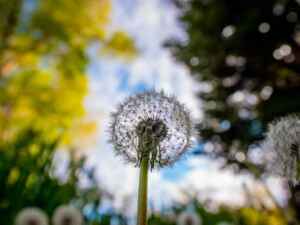Fixing a Lawn Full of Weeds: Everything You Need to Know
Summer is in full swing, and those pesky annual weeds are back in town! What should you do? You don’t want to sabotage the surrounding grass while attempting to remove the invasive weeds. 
So, why does your lawn have so many weeds? Your lawn can have an overabundance of weeds due to factors such as:
- Weed seeds were brought in from another source. These sources include mulches, soil amendments, or they blew in from surrounding areas.
- Your yard has many bare spots that provide an excellent place for weeds to take root.
- The grass in your lawn is weak or has thin regions that can’t compete with weeds.
- Weeds have grown out of control for too long without being maintained.
Weeds can be evidence that there is an underlying cultural issue in your landscape. In this article, we’ll examine everything you need to know about getting rid of the weeds in your lawn.
Getting Rid of Weeds By Recognizing Their Species
There are many weed keys accessible online or via lawn care magazines or books that can help you identify the type of weeds you’re dealing with.
An almanac is one of the best sources to identify weeds. Finding out what kind of annual weeds you are dealing with will help you know what best action to take is to get rid of them. It is easiest to control the spread of weeds by taking preventive measures.
On the other hand, perennial weeds are more difficult to control. These require that you dig them up by the roots, rhizomes, and underground tubers without leaving any fragments. Any pieces left will allow new weeds to grow.
To take care of perennial weeds:
- Cut off the emerging part of the weed. Keep cutting it each time it grows back. By cutting off the emerging part of the weed, you will not allow it to receive proper nutrition and sunlight without its leaves. This can weaken the roots underground and can aid in helping it die.
- If you dig out the weed, remove as much as possible. This may need to be repeated multiple times to remove the whole weed.
- Pulling out weeds is best done when the soil is moist. Make sure to grasp it as low on the stem as possible to avoid breaking it off prematurely.
Understanding Weeds Is Key Before Getting Rid Of Them
There are many different types of weeds. The Science Society of America defines a weed as “a plant that causes economic losses or ecological damages, creates health problems for humans or animals or is undesirable where it is growing.” Examples include crabgrass, common lambsquarters, or giant foxtail.
Another type of weed is called a noxious weed. These weeds are “any plant designated by federal, state, or local government officials as injurious to public health, agriculture, recreate, wildlife or property.”
Once a weed is classified as noxious, authorities can implement quarantines and take other actions to contain or destroy the weed and limit its spread.” For example, in the state of Oklahoma, noxious weeds include musk thistle, Canada thistle, and Scotch thistle.
The third type of weed is known as an invasive weed. These weeds “establish, persist, and spread widely in natural ecosystems outside the plant’s native range. When in a foreign environment, these invaders often lack natural enemies to curtail their growth, which allows them to overrun native plants and ecosystems.”
Not All Weeds Are Bad For Your Lawn
It is important to keep in mind that not every weed is a bad weed. There are close to 250,000 species of plants in the world, and only about 3% are plants we do not want.
Many weeds can actually benefit your turf by balancing the soil as well as adding organic matter. Some even provide habitat and food for wildlife, and some are edible for human consumption.
The first thing that you can do is identify the weed species growing in your yard. By identifying the weed species that live on your lawn, you will know how to manage them best.
Some weeds will be more aggressive and need harsher treatment, while others may grow more difficult to control. The best way to deal with weeds is to take preventive measures. However, if you were not preventive, you can still treat your lawn.
Ways to Prevent Weeds In Your Lawn
The best strategy to control the weeds in your yard is to prevent them. If possible, it is best to look at non-chemical methods for controlling weeds. Herbicides may be a quick fix to a problem, but it will not keep weeds from reoccurring year after year.
The only way to prevent the problem for the future is to take preventive measures! By not allowing weeds to take root, you prevent them from flowering and producing seeds. Some preventive tips include:
- Weed when they are young. You can easily pull them up or cut them. Ensure that you discard the weed you’ve uprooted or cut instead of leaving it on the surface of your turf. The best time to remove weeds is when the ground is moist, especially after it has rained.
- Regularly mowing can keep weeds from reproducing.

- Keeping your garden tools clean can help prevent the spread of weeds.
- Be careful about buying materials from garden centers that contain weeds or weed seeds. Some mulch, manure, compost, and soil can contain weeds, so make sure to read things like grass seed labels to ensure they don’t include other crop seeds.
- Seasons when weeds are not prevalent, like spring and fall, you can break four to eight inches of soil, rake it, and cover it in plastic about six to eight weeds before seeding.
- Once you sow, be careful not to till a garden area if there are perennial weeds. If you do, you will end up spreading weeds around.
- When you water your garden, be sure to water around your plants and not the entire garden. If you sprinkle water over the whole area, you will also be watering the weeds.
- Applying a layer of mulch makes it harder for plants to break through when growing. It also blocks sunlight from nourishing weeds.
- Be careful not to over or under-fertilize.
- By establishing a parameter, you can keep an eye on the areas near the edge of your flower bed, garden, natural area, or lawn. When weeds try to creep into the area you have blocked off, you will see them before they overtake your yard or garden!
What Can I Do About the Weeds Currently In My Yard?
Keeping the weeds out of your yard can be difficult, but weeding frequently can help manage what grows. Many people choose to treat their yard with either chemical or natural treatments on top of weeding. Most people opt to put chemical treatment all over their lawn.
However, when you do this, you don’t just put it on the turf. It also has an effect on the air and the water in the ground. Using this can be dangerous to humans and pets! Chemical treatments can even kill off the plants you want to have growing in your yard. However, not all chemical treatments are horrible for your lawn. Instead, they can be beneficial to your lawn.
You can also treat your turf with more natural methods. You can even make your own with vinegar, salt, and dishwashing liquid. Strong vinegar is a proven natural weed killer that kills weeds above ground.
If weeds overrun your entire lawn, you can use herbicides to remove weeds. You will want to make sure that you purchase a herbicide that works best within the temperature range in which you live. You will want to read the instructions to ensure your grass will continue to grow after using that particular herbicide.
Some herbicides are selective and can be used around growing plants, while simultaneously killing others. This is when you will need to know which weed species you are trying to kill!
Herbicides should not be used around your vegetable garden. Many vegetables are related to weed species, so using herbicides can injure your plants. It’s best to pull weeds in your garden by hand. Herbicides can also leave residue in the soil and affect the growth of your vegetables. If they are necessary, make sure to spot treat, so you don’t contaminate your whole garden.
Remember that herbicides are just a short-term solution to a potential long term problem. By being proactive, you can maintain your lawn to best suit your needs! Herbicides are not particularly necessary to have an attractive lawn. If you properly maintain your yard, you won’t need to use any herbicides. Be aware that herbicides can damage not only your garden but also tree roots.
Common Types of Weeds
Some of the most common weeds you’ll come across include:
- Purslane
- Crabgrass
- Lambsquarters
- Pigweed
- Chickweed
- Dandelion
- Shepherd’s Purse
- Creeping Charlie
- Bindweed
- Quackgrass
- Canada Thistle
- Nutsedge
- Buckhorn Plantain
Everyone wants to keep their lawn looking beautiful. Now that you are aware of how to treat weeds in your yard, you can take the preventive measures necessary to keep your lawn looking the way you want!
American Lawns is here to provide solutions that are easy and do-it-yourself. If you need any of your lawn care or home insurance questions answered, scroll through our articles to see best practices for taking care of your lawn!

